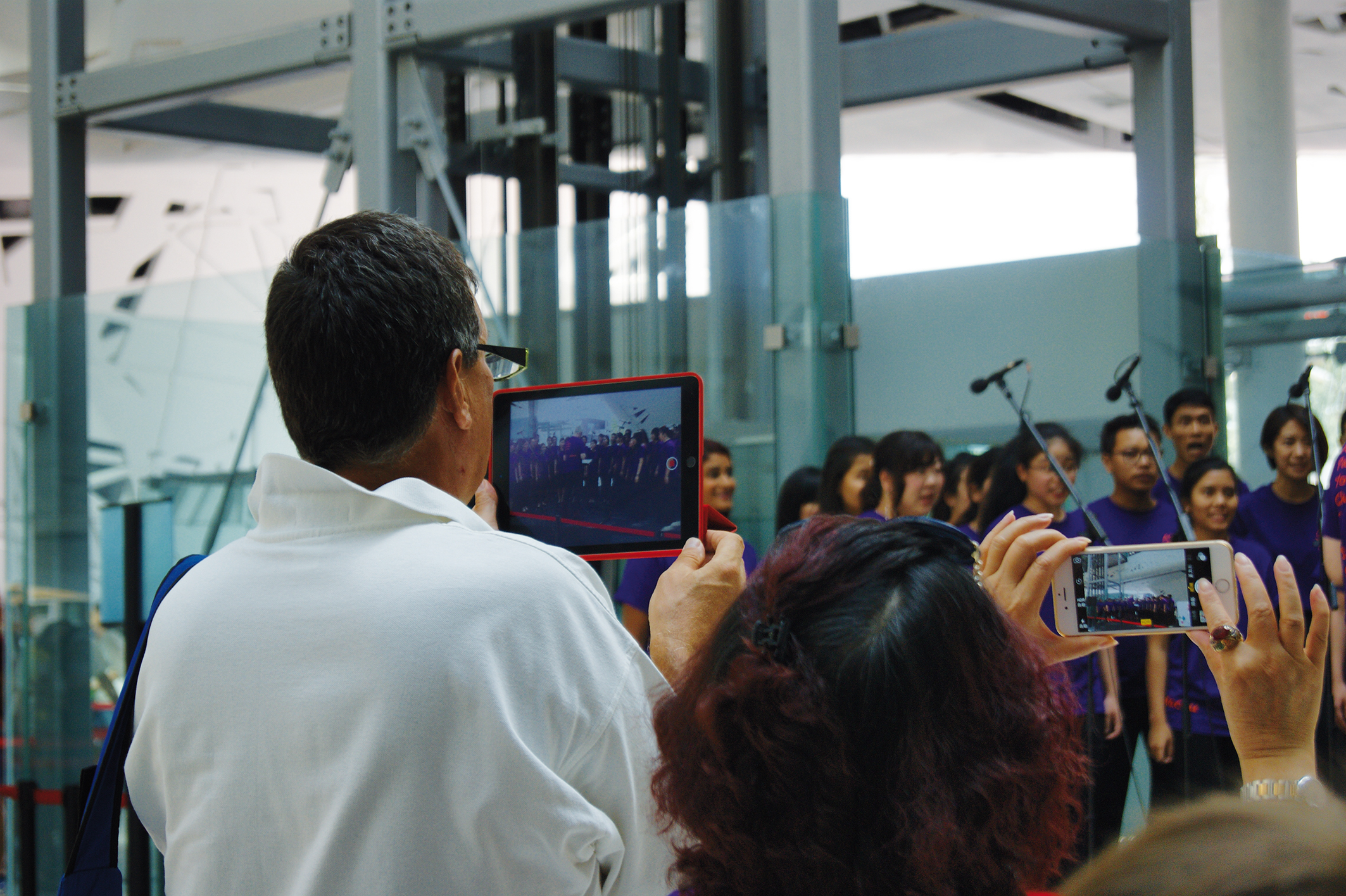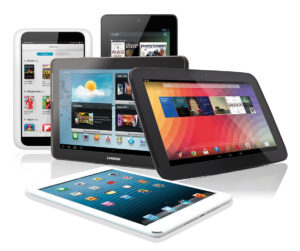By Philip Copeland, choral conductor and teacher
In our rapidly changing technological society, choral musicians and conductors often choose to explore the tablet computer as a replacement for their paper-based choral music folder. The benefits of the tablet technology are obvious to some conductors and musicians; many musicians have been using tablets for music making for years. Choral musicians were sharing insights into tablet computing as early as 2011, when musicians from the singing group “Schola Cantorum” uploaded a video to YouTube detailing these observations:
- The tablet is much more compact than a choir folder; it translates to more elbow room on the concert stage.
- The tablet offers the singer the opportunity to have all of the music that they need all of the time.
- There is tremendous flexibility to mark up music with different color markings, annotations, and edits.
- In the concert, page turns are silent.
- Music reading apps, that include forScore for the ipad, have extra features that include a metronome, pitch pipe, and the ability to link to a digital recording of the music.[1]
A Variety of Operating Systems
It was only six years ago when Apple’s iPad disrupted the technological world. Since then, Google’s Android tablets and Microsoft Slate tablets have made valuable contributions to the market. Choosing your operating system is an important first decision to make in the process of finding the right tablet computer for you.
The most popular system for musicians seems to be the Apple iPad, although the Android system has made tremendous strides in recent years. Window’s Slate computers seem to be in third place, but the company continues to be a significant player in computing.
According to PC Magazine’s recent article “The Best Tablets of 2016,” the general benefits of each system break down like this:
Apple iPad: offers huge library of apps and a clean, intuitive interface
Android tablets: offers hardware from different companies, great notification system, smooth web surfing, and seamless integration with Google’s gmail, maps, and video chat.
Windows slate: comes closest to giving a full powered computing experience, including the ability to run the full version of Microsoft Office in the Win 10 tablets.[2]
In terms of market share, Android dominates with nearly 2/3 of the operating systems in smartphones and tablets (66.7%). Apple comes in second with 27% and Windows garnering less than 3% of the market.[3]
Leading Tablets for 2016
These three operating systems offer musicians a variety of choices based on the priorities of the individual. A user’s past technological experience is often a governing factor in choosing a tablet. Windows users are likely to feel a strong comfort level with Microsoft slate tablets while Apple MacBook users tend to find comfort in the iPad ecosystem.
Screen size and storage capacity are important considerations, especially for those who want to use their tablet in a concert situation. Younger musicians may have little trouble reading music on a smaller screen while those over the age of 45 may find it impossible to focus on their musical notes when they are displayed on a seven-inch screen. As the screen size grows, the weight of the device increases; users will want to consider how heavy their tablet if they plan on holding it in their hands during a concert.
Android devices from Google
If price is the greatest determining factor, the Android operating system seems to be the best choice. According to the “Android Authority” website, the best tablets that feature this operating system currently include the Google Pixel 3, Google Nexus 9, Samsung Galaxy, NVIDIA Shield Tablet K1, and the Sony Xperia Z4 Tablet.[4] The prices range from $200 – $650, depending on a variety of factors that include screen size, storage needs, and internet connectivity options.
Window Tablets from Microsoft
In June 2016, PC Magazine did a roundup of the top windows tablets. Included in their recommendations were the Microsoft Surface Book, the Acer Aspire Switch 11V, the Dell Venue 8 Pro 3000, and the Lenovo IdeaPad Miix 700.[5] Prices of these tablets range from $299 – $1349, with many other devices listed and reviewed. As with Android devices, prices vary according to processing power and size/storage choices.
iPad offerings from Apple
Apple’s offerings have diversified in recent years and they now offer iPads in three size categories. Two are mini-size (7.9 inch), two are standard size (9.7 inch), and the largest is the 12.90inch iPad pro. Prices follow the size offerings, with the two smallest mini-iPads coming in at around $250 (mini 2) and $500 (mini 4), the iPad 9.7 inch air starts at $399 and the two iPad pro tablets start at $599 for the 9.7 inch and $799 for the largest iPad. With the maximum storage and connectivity option, the largest iPad costs $1229.
Music Reading Applications
Most any tablet can function as a music reading device when the music is converted into Adobe’s PDF format. Android has many options for PDF annotation, including Adobe Reader (free), ezPDF Reader (free/$3.99) and PDFMax (free/$7.99). Windows has similar apps, including ezPDF Reader (free), PDF Annotation (free/$3.99), and PDF Notes ($3.99). In the iOS system, a number of PDF annotation programs exist, including iAnnotate ($9.99), PDF Expert 5 ($9.99) and GoodReader ($4.99).
Software options should be a strong consideration for any choral musician contemplating the purchase of a tablet. When it comes to software, Apple’s iOS system has the largest number of offerings as well as the most mature product. Android programs are quickly catching up and Windows machines have several options.
Android
Although the Android operating system is more pervasive than Apple or Microsoft, the music reading applications are smaller in number and less mature in development. Leading music reading applications for the Android operating system are MobileSheetsPro Music Reader from Zubersoft ($12.99), MuseScore (free), and Orpheus Sheet Music Pro ($3.81).
Windows
Windows tablets have several options. MusicReader PDF 4.0 is a program that runs on Windows software and also on iOS platforms. The program promotes a library for storing music, hands-free page turning ability, annotations, and an integrated recorder/player option as well as a metronome and tuner. Another app, SheetMusic by Bug Bytes, calls itself “a musician’s electronic performance binder.”
iPad
The iPad offers the largest number and variety of apps for the choral musician. Topping the music reader application offerings is forScore ($9.99) by MGS. This application was one of the first music reading apps to appear with the iPad and has matured into an essential program for an iOS user. Another popular music reader for the iPad is the DeepDish GigBook by Deep Dish Designs, LLC ($9.99). Designed specifically for the performing musician, this app excels in providing a large music library and sophisticated setlist design. Other notable apps include unrealBook ($8.99) and NotationPad ($8.99).
Disadvantages
While tablet computing adds much to the choral musician in the rehearsal and performance, there are some disadvantages that have emerged in rehearsal and performance. The most obvious disadvantage is that the tablet is an electronic device powered by a battery. A low charge at the wrong time in a rehearsal and a performance can render the performer unprepared to rehearse or unable to perform!
Any electronic device in rehearsal offers the opportunity to distract the singer or conductor with the ever-present text message, email notification, or other distraction. Maturity is an important aspect to consider when considering the use of a tablet in a musical setting.
With most music reading and PDF annotation apps, the process of marking the score is usually slower than a pencil on paper. The slight delay in accessing the annotation features of the app will add up over time.
Conclusion
Technology is changing the world of choral music in large and small ways; tablet computers are entering our rehearsal spaces and concert halls. With patience and wisdom, we will find ways to adapt technology’s potential to our ultimate goal of teaching music more efficiently and making music with a more unified performance of the composer’s original vision.
[1]Observations from this video were captured in the post “Video: Using iPads and Tablets for Choir Rehearsal and Performance [via Schola Cantorum]” https://techfortheclassicalsinger.wordpress.com/2012/07/10/video-using-ipads-and-tablets-for-choir-rehearsal-and-performance-via-schola-cantorum/
[2] http://www.pcmag.com/article2/0,2817,2413145,00.asp
[3] https://www.netmarketshare.com/operating-system-market-share.aspx?qprid=8&qpcustomd=1
[4] http://www.androidauthority.com/best-android-tablets-267136/
[5] http://www.pcmag.com/roundup/310159/the-best-windows-tablets


